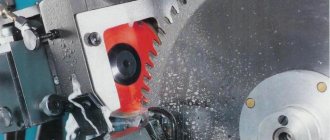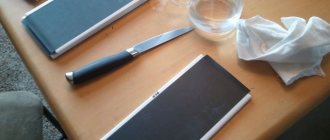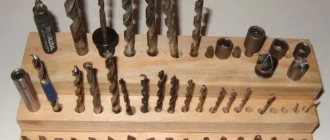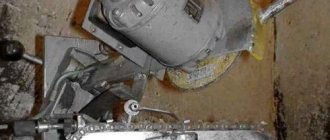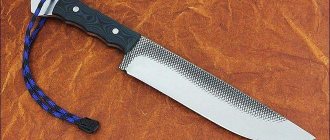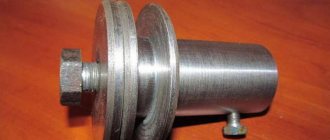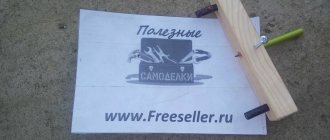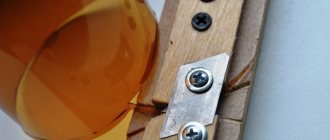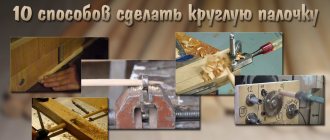A problem arose: to repair the equipment, I needed to accurately drill several holes with a diameter of 2 mm in a steel plate, and the drills turned out to be so blunt that they burned and did not work.
I tried to sharpen them on a homemade sandpaper made from a three-phase asynchronous motor with a simple capacitor start. The machine in the photo: a tool rest with markings for sharpening drills.
However, my skills and coarse-grained corundum stone allow me to edit drills from 4 mm relatively well, but problems arise with smaller diameters. You need professional equipment.
This need shaped the task: to make by hand a device for sharpening small drills, as simple and reliable as a metal bolt. I took as a basis an idea from the Internet (used for a long time) called Wishbone (in our opinion - Wishbone), which I talk about below in this article.
I had to work in the evenings in the kitchen of a city apartment, not a private house, after all stages of dinner had been completed. Naturally, I sawed, drilled and leveled almost on my knees with the most accessible hand tools.
Therefore, Vishbon was completed only on the second day, although in a workshop, using a grinder and a drilling machine, it can be done in a couple of hours.
In general, advanced users quickly print this device on a 3D printer and get high-quality samples of hand tools.
Wishbone - what a drill sharpening device can do and what functions it cannot do
This product allows you to fix dull and broken twist drills quite quickly and shape their cutting edges, just like in a factory for home use.
The main feature of the device: it does not require high sharpening skills; anyone can use it. The design is not complicated.
It’s worth immediately taking into account that such a homemade product only performs two-plane sharpening. Its capabilities are limited to two functions:
- by forming an angle at the apex, and you can deviate from the standard value for steel of 120 degrees and grind other values. A table of the dependence of angles and parameters of different types of processed material are published in reference books;
- creating a rear cutting angle.
Apex angle
Relief cutting angle
You can talk about them for a long time, but it’s unlikely that it will be better than Viktor Leontyev (a real master) on his YouTube channel. For those who don't know this, look there. I think I should warn you - this is important!
In principle, the correct creation of these two angles is sufficient for working with small drills at home, and often in production. Sharpening the jumper with this device will not work. You need to use a special machine.
Top 2. Prostormer PTET1058
Rating (2021): 4.85
574 reviews taken into account from resources: AliExpress
The most popular This electric drill sharpener already has 1250 orders and almost 600 reviews on AliExpress. In them, site users praise the device and recommend it for purchase.
- Characteristics
Average price: 1912 rub.
- Power: 95 W
- Noise level: 64–75 dB
- Rotation speed: 1600 rpm
- Grinding disc diameter: 75mm
- Suitable for drill bits: 3-12mm
A stationary household sharpener, the main advantage of which is its low price with a good level of quality. PTET1058 does not require any additional accessories; you just need to connect the device to a power outlet and it will be ready for use. The device is suitable for processing most drills due to the increased diameter of the grinding disc. The main complaint from users is the complexity of the sharpening process. The set with the sharpener itself includes instructions in English, and video tutorials are also posted on the Internet, but figuring out how to properly control the sharpening angle of the drill is not so easy. Those who managed to master the intricacies of the process speak very positively about the device.
Advantages and disadvantages
- Fast connection without additional devices
- Large diameter grinding disc
- Operational sharpening
- Durable material and quality build
- Complex control and sharpening angle control
- Not suitable for the smallest drills
Buy on AliExpress.com
See also:
- 20 best knife sharpeners from AliExpress
Save up to 10% or more when shopping on AliExpress! Use current promotional codes and coupons.
Personal experience of making a Wishbon instrument at home with your own hands
You can choose any body material, of different compositions:
- aluminum sheet or soft alloys;
- plastic;
- laminate or fiberboard;
- polyethylene or fiberglass;
- even a wooden plank.
I settled on a plate made of getinax: it is easy to process and has high strength.
To make the case, I drew a sketch on a squared notebook sheet. No drawings needed. Scale 1:1. I placed a small drill on it as a size guide.
For clarity, I outlined the dimensions with a red pencil and showed the corners.
After that, I drew the dimensions on the getinax. I drilled holes in the body of the future device.
Since I didn’t have a normal drill, I had to make a homemade one based on the cannon drill principle. I used a piece of a spoke from a Soviet bicycle. Diameter 2 mm.
I filed off part of the side edge and sharpened the end into a central corner. On the one hand, it is a parody of a cannon weapon, but it is a completely working design for soft materials.
It is permissible to make them even from nails and wire of different diameters. This way you can make different types and diameters of such tools. No special precision is required. My finished drills are shown in the photo.
From the getinax I used a hacksaw to cut out a body blank and an additional part for attaching the wheel - a regular washer for an M3 nut. I used a 4 square piece of copper wire as an axis. In order for the wheel to rotate well, a spacer had to be installed.
The method of connecting parts is conventional riveting. Vishbon showed the rest of the details in the photo.
The clamping block (a pentagonal figure in the photo) was made with holes with a diameter of 4 mm.
In the central part of the body, I had to use homemade drills to increase the diameter of the hole and cut the thread. I made the tap with my own hands from an M4 hairpin: I sharpened one end slightly into a cone and cut part of the thread along the length from opposite sides with a hacksaw.
From the opposite end of the thread, I clamped two nuts against each other, which allowed me to work with it with a wrench.
Homemade tap
I must warn you: it’s easier to work with a factory tap. But, in a critical situation and for soft materials, this design is justified.
In the middle of the 120 degree angle I scratched a bisector, which serves as the basis for laying the thinnest drill bits.
I reduced the height of the body so that even the smallest drills protrude from it: this makes it easier to install them.
In the upper part of this, Vishbon made a mark at the exit of the angle bisector to facilitate the assembly process: centering the axes of large drills when fixing them in the fixture.
The mark indicates the center of the drill.
Homemade sharpening machine for autonomous type drills
If desired, you can make a sharpening machine for straightening drills, the design of which will have its own electric drive motor. Such equipment will be completely autonomous and will not have to be attached to an existing grinding machine.
The frame of such a compact machine can be made of plexiglass or textolite 10 mm thick, and an electric motor from an old fan can be used as a drive motor. The guide element of such a machine, on which the stop for the drill shank is fixed, works on the principle of a conventional caliper. The angle at which the drill, which has the ability to move in the horizontal direction, is sharpened is set by using a rotary platform.
9 main rules for working with Wishbone, without which it is impossible to achieve a good result
I show them in the form of step-by-step instructions with a strict sequence of actions. However, keep in mind: there are two ways to work with Wishbon:
- straightening dull factory edges;
- bringing broken drills back into working condition.
How to straighten dull edges
1. Loosen the clamping screws and insert a drill under the fixing plate, tighten the fastening without fanaticism: you will need to make adjustments.
2. Using a magnifying glass, set the drill so that the cutting edges are parallel to the plane of the body or wheels. It is very convenient to turn it with pliers.
3. Adjust the sharpening angle at the tip. To do this, we install some kind of even guide, for example, a ruler, on the top of the drill and the wheel. The planes of the fixture and the reference line must be parallel.
But if you need to make the sharpening angle not 120 degrees, but less, then we simply move the drill a little higher, as in the photo.
To accurately set a certain degree value, the required angle is drawn on a sheet of paper using a protractor and its bisector is drawn. The device is oriented according to this template.
4. The fastening screws are tightened until they stop. The drill is fixed. After this, you need to repeat the measurements in steps 2 and 3. Be careful and careful as a necessary condition for accurate sharpening.
5. Place the Wishbone vertically on the grinding surface of an abrasive stone or sandpaper, laid on the most even surface, for example, glass or plastic.
Then we tilt it at a slight angle from the vertical to cut off the occipital region. At first, a simple template will help.
After sharpening several drills, it will lose relevance due to the skills developed.
6. All that remains is the sharpening itself: the Wishbone is lightly pressed against the abrasive surface of the sharpening device in the set position (large loads are harmful), and smoothly moved away from you, always placing the wheel in front.
Without reaching the end of the abrasive surface and without further touching it, the device is lifted and carried through the air to the beginning of the abrasive. The process is repeated several times.
During each sharpening, it is very important to always point the Wishbone in only one direction: away from you.
7. The Vishbon is rotated 180 degrees around the axis of the drill and completely repeats steps No. 5 and 6 for the second edge.
8. Using a magnifying glass (the eye gauge may fail), a visual assessment of the condition of the cutting edges, apex angles and rear cutting is made. If necessary, repeat steps No. 5 ÷ 8.
9. Sharpening ends with one pass for each side, which ensures the removal of the remaining burrs on each of the cutting edges. The edges will be perfect. I advise you to check it.
I should note: when I first made Wishbone and immediately began sharpening the drill for metal, acting on a whim, I neglected most of these rules. As a result of the test, it was possible to drill only an aluminum plate, but failed to drill a steel one. There was no hole.
I showed this entire process of sharpening and drilling in the video below. You should do everything right at once, without unnecessary haste.
How to sharpen a broken drill bit on Wishbone
The process described above for broken drills will take a very long time. Therefore, the damaged end must be ground off using an emery wheel.
You can also use a drill:
- insert the broken drill into it;
- turn on reverse;
- set an angle of 60 degrees to the sharpening stone. This tilt is important;
- start the engine;
- Carefully grind the broken end onto the cone. Follow safety requirements.
Now all that remains is to repeat all the steps to correct the edges and additionally restore their shape.
Good abrasives quickly grind down thin drill bits. Therefore, after 20 passes on the surface being treated, conduct a visual assessment of the cutting edges and angles and re-adjust them.
Types of sharpening
Some types of sharpening have already been mentioned above, but we will repeat it again. So, there are five types of sharpening, which are selected based on the type of material and the specifics of the work associated with drilling.
The first of them is normal under the title “N”. This variety is universal, but is used only if it is necessary to sharpen a drill with a diameter of no more than 12 mm. Essentially, two cutting edges and one transverse edge are formed on the tool. To do this, you have to maintain an angle within 118-120°.
And the rest:
- NP – sharpening is done with a short crossbar to reduce the load on it;
- NPL - in addition to the transverse edge, the width of the ribbon is also reduced, the goal is to reduce the friction force that is created between the drill and the workpiece;
- DP is the so-called double sharpening, where in addition to the transverse edge, four more edges are formed, which are broken lines;
- DPL is the same previous version, only the ribbon is additionally sharpened.
Attention! Why are four edges needed? This is an opportunity to reduce the angle between sections of the peripheral planes of the edges. Thus, an increase in heat removal from the drilling site is achieved. And this increases the service life of the tool itself.
Correctly carried out sharpening of a drill Source tehnomuza.ru
Wishbone alternative design: what are the differences between the tool
An alternative is to mount the guide wheels across rather than along the main plane of the housing. I hope that making such a device is not difficult. But 3D printing will require drawings.
In this case, drills are sharpened perpendicular to the plane of the cutting edges. For some, this feature of the tool is fundamentally important...
I do not think so. It is necessary to take into account that a spiral drill for metal, using a stationary machine, can be sharpened in different ways:
- the already mentioned Victor Leontyev performs this action, placing the cutting edge across the rotation of the emery;
- sharpener Nikolai Kulikov places it parallel. Watch his channel “Kulikov Experience” on YouTube.
Both techniques of these experts work correctly and have a number of advantages and disadvantages. Welders sharpen drills with a grinder. They always have this tool at hand: it allows them to cut off any bolt, angle, channel, or fragments of metal elements.
Homemade people make a sharpening machine, which is adapted for straightening drill elements on the side of an emery wheel... Such devices, I must note, are not suitable for everyone.
There is no universal advice. Which design should be chosen and used for sharpening metal drills with your own hands - decide for yourself.
Top 5. Alloet Drill Bit Sharpener
Rating (2021): 4.60
354 reviews taken into account from resources: AliExpress
Best Price Due to the fact that this sharpener works without electricity, it has the lowest price on AliExpress. This option is suitable for hiking conditions.
- Characteristics
Average price: 411 rub.
- Power: no
- Noise level: no
- Rotation speed: no
- Grinding disc diameter: 32mm
- Suitable for drill bits: 2–12.5 mm
The principle of operation of a motorless sharpener is the simplest - the plastic part of the nozzle is installed on the chuck of an electric drill. After turning on the motor, the chuck begins to rotate the grinding wheel. Thanks to this, the drill comes into contact with the abrasive stone at the desired angle. The model has 3 grooves of different sizes for fixation. The quality of this sharpening is not ideal, but the product turned out to be a useful tool for home craftsmen. A significant advantage of Alloet is its small size. The sharpener takes up minimal space and is always at hand. The downside is the lack of rigid fixation of the drill during operation. Therefore, you have to hold it with your hands. This means that the quality of sharpening depends on the skills of the master.
Advantages and disadvantages
- Minimum price
- Light weight and dimensions (185*40*32 mm, 120 g)
- Simple and intuitive controls
- Various configuration options
- You need to hold the drill firmly in your hands
- Average sharpening quality
Buy on AliExpress.com
Conclusion
A drill attachment for sharpening drill bits is a very useful purchase if you often work with drilling tools. Thanks to it, you can significantly save money on the services of service centers. It is only important to calculate the capabilities of such a product so as not to overload it so that it does not fail. Naturally, a drill, even with such a device, cannot completely replace a sharpening machine, but if you need to sharpen a drill at home, it will allow you to complete everyday tasks without difficulty.
Specifics of device operation
Electric drills and screwdrivers are often used in households for drilling various materials such as wood, concrete, metal and ceramics. Many users of such equipment have repeatedly encountered a problem that causes the working part of the drilling tool to become dull during operation.
When working with metal, intense heating of the cutting part of the drill may occur, which exposes it to rapid wear and further unsuitability for use. To avoid this, it is necessary to periodically check the geometric standards of the cutting part and, if possible, sharpen it to the required parameters. Twist drills are usually used for drilling metals. Additional checking of the tool before performing work extends its service life.
When working with wood, the cutting part is practically resistant to wear, and concrete drills are equipped with hard pobedit plates, which do not need sharpening and are used until they are completely worn out.
https://youtube.com/watch?v=E2G6AZwT17w
